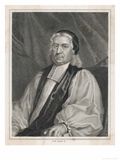| At the age of 33 he landed the rectorship of St Stephen Walbrook, then in the 1750s, in the rectorship (or “curacy” as it was known) of St Margaret Westminster, next to the Abbey, he became known as a ‘pioneering advocate for the propriety of decoration in Anglican churches.’ |

Thomas Wilson, engraving by John Simon, after Richard Phillips.
Thomas Wilson was the son of the Bishop of Sodor and Man, and his wife Mary was the daughter of the wealthy Warrington industrialist Thomas Patten. ‘As a young man he began his career in the clergy with an appointment to his father’s diocese. For some years he continued as a churchman and after marrying his cousin,’ Mary Pattern, who had a house in smart Stoke Newington, ‘sought ecclesiastical preferment in London with some zeal.’ At the age of 33 he landed the rectorship of St Stephen Walbrook, then in the 1750s, in the rectorship (or “curacy” as it was known) of St Margaret Westminster, next to the Abbey, he became known as a ‘pioneering advocate for the propriety of decoration in Anglican churches.’ (http://www.pmsa.org.uk/pmsa-database/4976/)
‘The churchwardens of St Margaret’s wanted to install some beautifully made16th-century stained glass in the east window above the altar … The Chapter of Westminster Abbey, unhappy with images of angels collecting the blood of Jesus (a Eucharistic statement) opposed its installation and went to law. Thomas Wilson dug in his heels. Thanks to him, this window, one of the finest of its period in London, survives to shed its rich light.’ (http://www.telegraph.co.uk/comment/12059739/Westminsters-gift-from-an-infatuated-rector.html#disqus_thread).
Read more
In 1761 he edited and contributed to William Hole’s important Ornaments of Churches Considered, a book about the decoration of St Margaret Westminster which helped mark a new interest in introducing visual art among Anglicans. Then in 1776 he presented to St Stephen Walbrook a very large painted altarpiece, made for the east window of the church, and depicting Devout Men Taking the Body of St Stephen, painted by Benjamin West, President of the Royal Academy.
‘As they grew older however, the Wilsons became frequent visitors to Bath and these visits increased until Mary’s death in 1772, when he became a permanent absentee from his London church. Two years later, he made the acquaintance of [the celebrated author of a History of England] Catharine [Macauley] and she began lodging with him. This caused much public comment as she was 43 and he was 71. Wilson became something of a laughing stock, but his infatuation was so strong that he commissioned [John Francis] Moore to sculpt the statue for his church … The piece [entitled ‘History’ but depicting Macauley] was … unveiled in St. Stephen’s Church, Walbrook, on 8th September 1778, in the chancel, but it found itself banished from the church not long afterwards … There was much indignation as to the placing of the piece (apparently between the altar rails) and the inscription it bore at the time written by Dr. Wilson.’ This included the following: ‘You speak of Mrs MACAULAY / She is a kind of Prodigy ! / I revere her Abilities; / I cannot bear to hear her Name sarcastically mentioned: I would have her taste exalted Pleasure of the universal Applause: / I would have STATUES erected to her Memory.’ (http://www.pmsa.org.uk/pmsa-database/4976/)
The sculptor John Francis Moore also crafted the memorial to Thomas and Mary Wilson which can still be seen in the church and which has a double inscription underneath a roundel with a relief sculpture of a ‘female figure and two infants, one suckling, the other holding an anchor, and a worn figure of woman with tall cross and bell behind.’ (http://www.speel.me.uk/chlondon/ststephenwalbrook.htm)
Thomas Wilson was a pioneering patron of the Arts in a period when the influence of Puritanism, with its rejection of all things Catholic, remained strong. In 1761 Wilson advocated the then unusual practice of placing lighted candles on the altar during celebrations of the Eucharist. While in Ornaments of Churches Considered, he and Hole quoted approvingly the following: ‘As ornament and instruction are all we contend for, I should prefer large historical paintings to single figures, and this the more willingly, because adoration has at no time, nor in any place, been paid to them.’ Wilson followed this direction himself with the commissioning of Benjamin West’s altarpiece for St Stephen Walbrook. He showed courage and conviction in reintroducing the visual arts to a church that, in large part, still rejected them as tainted by Catholicism.
While genuinely pioneering Wilson’s commissions also reveal some of the pitfalls of patronage. Wilson imposed his commissions on his churches without regard for their existing aesthetic and integrity. The Benjamin West altarpiece, for example, completely covered the East window at Walbrook and therefore rode roughshod over Christopher Wren’s design in a way that the later and equally controversial modern altar by Henry Moore does not. This was essentially the reason why it was put in storage and later sold. Wilson’s approval for large history paintings reflected fashions at the time which have not worn well. Finally, Wilson allowed his personal preferences and infatuations to influence his decision making, as with the controversy over the commissioning of the Catherine Macauley sculpture and its placing in the sanctuary.
Read less
